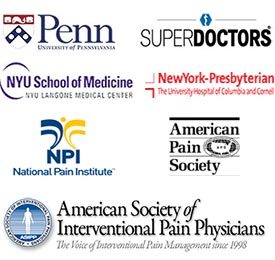Iliotibial Band Syndrome Specialists NYC
At Manhattan Pain and Sports Associates you’ll receive proper illiotibial band syndrome diagnosis, pain management, and the medical care from our doctors that you need to reduce or eliminate your pain. Because when you’re in pain — whether it’s from an accident, age, sporting injury or ailment — you want relief. Appropriate and targeted treatment starts with a definitive illiotibial band syndrome diagnosis from our specialists.
Iliotibial Band Syndrome
This condition may be a mouthful to pronounce, but remember that the tibia is the main weight-bearing bone in your shin. The iliotibial band, or ITB for short, is a tendon connecting the top of your pelvis to a long muscle — also called the iliotibial band — that runs down the outside part of your leg to your tibia, just below the outside edge of your knee.
Illiotibial band syndrome occurs when the band rubs against the outer bone in your knee, causing irritation and swelling. ITB syndrome hits NYC joggers and cyclists the hardest, since they tend to stress their leg muscles more than others and for longer periods of time. While iliotibial band syndrome sounds scary, it’s completely treatable by a pain management specialist.
What Causes ITB Syndrome?
Iliotibial band syndrome affects many people for different reasons. Even those you don’t jog or bicycle can be stricken with this malady. Some of the more common causes of ITB syndrome include:
- Bowed legs that put additional stress on your ITB
- Poor physical conditioning
- A lack of warm-up exercises; the sudden exertion can stress the ITB
- Changing and irregular physical activity
- An ITB that’s already stressed from any of the above
An irritated bursa sac between your tibia and the ITB tendon causes your pain. Normally, the bursa sac, which contains lubricating fluid, prevents friction in that part of the knee, but when the sac itself becomes irritated, it swells and causes the pain.
ITB Syndrome Symptoms
If your iliotibial band is tight, you’ll feel some pain around the outside part of your knee when you bend it. As you warm up, though, the pain subsides. If you have ITB syndrome, the pain gets worse instead of going away. The more you exercise, jog or bicycle, the worse the pain gets. With a bad case of the condition, your pain increases if you run downhill or sit for long stretches with your knee bent.
While the pain you feel may vary depending on your activity level, you will always feel it most sharply on the outside part of your knee. Bending it can cause pain, although you won’t have any problems putting your weight on that leg.
Treatment for UTB Syndrome
Ice your knee for short duration - about 15 minutes. Anti-inflammatory medications can often help also. You should see Manhattan Pain and Sports Associates, however, if the condition persists for longer than several days, we are very familiar with ITB syndrome.
After talking to you about when the pain started, as well as when and where it feels worst, your knee pain doctor can test your knee for direct evidence of ITB syndrome. In extreme cases, the doctor can administer a cortisone injection into your knee, which reduces the swelling and the pain. You may need to rest or switch exercise regimens temporarily, and you may need to do special exercises to stretch and strengthen your iliotibial band.
Get the Relief You Need
Your NYC pain management doctor’s goal is to get you back to your normal routine with minimal downtime. After your diagnosis is confirmed, your doctor begins your treatment plan with the most conservative pain relief treatment. You’ll always receive non-invasive pain relief before your doctor turns to more invasive procedures like surgery.
Manhattan Pain and Sports Associates
51 East 25th St, 4th Floor, Ste B
New York, NY 10010
(212) 533-3954



